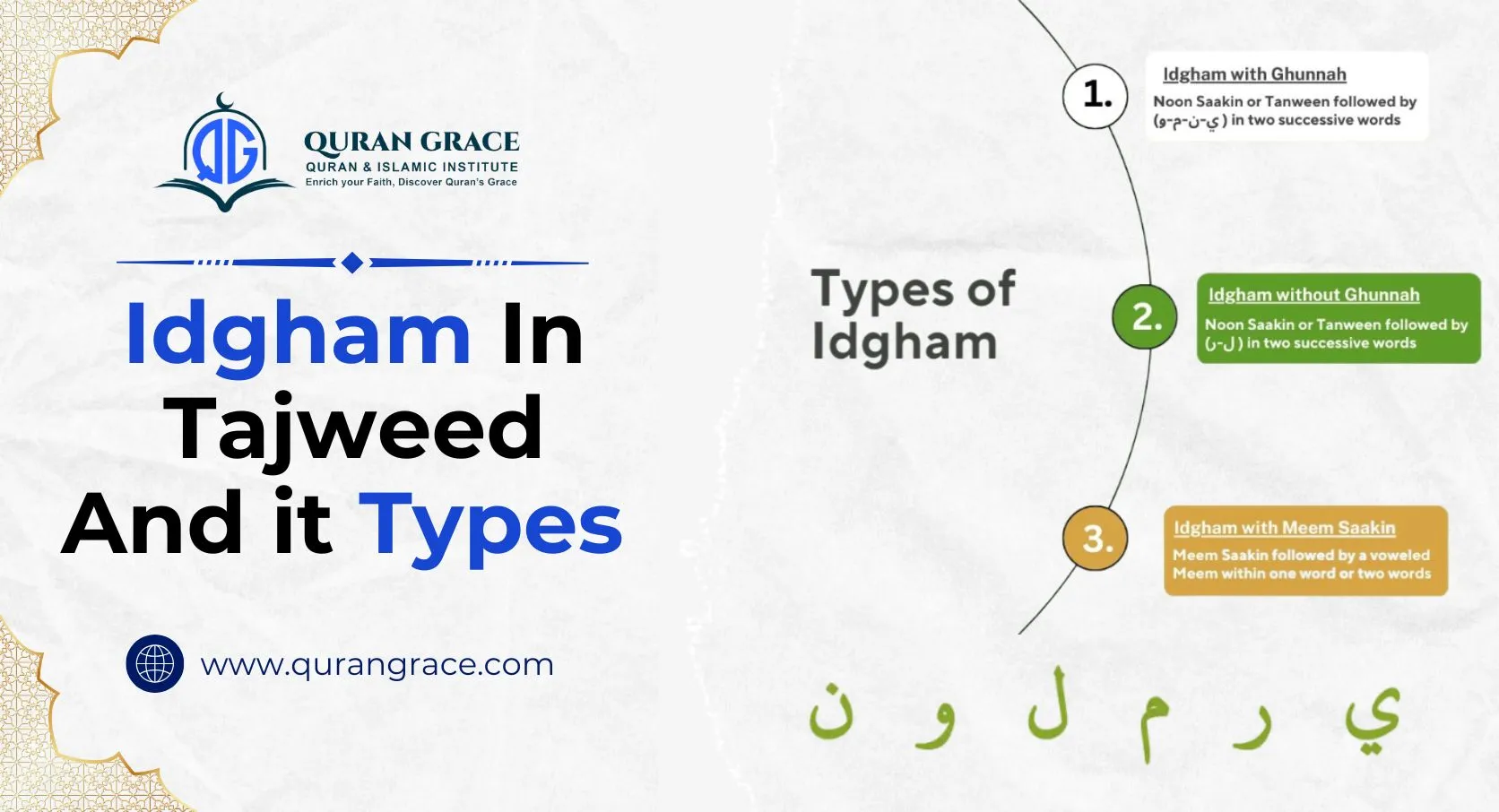Idghaam is an important concept in Tajweed that refers to the merging or blending of two letters when pronounced together. Different types of Idghaam occur in the recitation of the Quran.
In Tajweed, Idghaam specifically pertains to the merging of the sound of ن (noon), along with Sukoon or Tanween, into the following letter, based on specific conditions. This rule is essential as it helps maintain a smooth flow and recite the quran beautifully.
Table of Contents
ToggleWhat is Idgham In Tajweed?
Idgham in Tajweed refers to the merging of Noon Saakin (نْ) or Tanween (ً ٍ ٌ) into the following letter, creating a smooth transition in pronunciation. This occurs when one of the six Idgham letters (ي، ر، م، ل، و، ن) follows Noon Saakin and Tanween, causing the sound to blend into the next letter. Idgham is classified into Idgham with Ghunnah (when merging with ي، ن، م، و, producing a nasal sound) and Idgham without Ghunnah (when merging with ر، ل, without nasalization). This rule enhances fluency and beautifies Quranic recitation by facilitating smoother articulation.
Let’s explore these types in more detail:
Types of Idgham in Tajweed With Examples
When two letters occur consecutively in a word, they are merged according to the fundamental Tajweed rule of idgham. Idgham can be divided into various varieties, each with unique guidelines and traits. Below, let us examine them:
1. Idgham With Ghunnah
Idgham with Ghunnah occurs when a consonant letter—specifically waw (و), yaa (ي), noon (ن), or meem (م)—follows a Noon Sakinah or Tanween. In this case, the two letters blend into a single stressed letter while incorporating the nasal sound known as Ghunnah.
Put simply, Idgham with Ghunnah happens when a Tanween or Noon Sakinah is succeeded by any of the letters mentioned above. The nasal sound is smoothly assimilated into the following non-nasal sound, resulting in a slight nasalization that is stretched out for one vowel count.
To indicate Idgham with Ghunnah, a small circle is placed above the non-nasal letter. The duration of the Ghunnah is typically around two seconds or two beats.
Example of Idgham with Ghunnah in the Quran
An example of Idgham with Ghunnah is found in the verse “وَجَعَلْنَا سِرَاجًا وَهَّاجًا” (Surah An-Naba:13).
In this example, the letter و (waw) in the word وَهَّاجًا comes after Tanween, and its sound hides the sound of the letter جً (jeem), which is joined with the letter و (waw).
The letter أ (alif) at the end of the word سِرَاجًا becomes unclear or merges with the previous letter due to Idgham with Ghunnah.
2. Idgham Without Ghunnah
Idgham without Ghunnah occurs when a nasal sound is absorbed into a non-nasal sound without extending the nasal sound. This phenomenon is indicated by a small vertical line placed above the non-nasal letter.
In simpler terms, Idgham Without Ghunnah takes place when either lam (ل) or ra (ر) follows the Noon Sakinah or Tanween. In such cases, the two letters blend into one pronounced sound of the following letter, without any accompanying nasalization (ghunnah).
The letters that fall under Idgham Without Ghunnah are specifically Laam (ل) and Raa (ر). When either of these letters comes after a Noon Sakinah, the Noon Sakinah is effectively hidden, and the following letter merges with either ل (Laam) or ر (Raa).
If Laam or Raa appears after Tanween, the reader should clearly articulate the ‘n’ sound that results from At-tanween.
Example of Idgham without Ghunnah in the Quran
An example of Idgham without Ghunnah is found in the verse from Surah Al-Baqara, 192:
- فَإِنِ انْتَهَوْا فَإِنَّ اللَّـهَ غَفُورٌ رَحِيمٌ
In this example, since Tanween in the word غَفُورٌ is followed by the letter ر (raa) in رَحِيمٌ, Tanween should be concealed and read with the Arabic phonetic sign Dummah, merging it with the next letter.
So, instead of pronouncing it as “Ghafoorun Raheem,” it should be pronounced without Ghunnah as “Ghafoor-ur-Raheem.”
Note: Quran Grace offers online quran recitation course specifically designed to teach Tajweed rules with proficiency.
3. Idghaam Taam (Kamil, complete)
Idghaam Taam occurs when a letter of the same type is dropped, causing the remaining letter to be fully stressed. This phenomenon applies to the letters lam, ra, noon, and meem. In Idgham Kamal, the first letter is completely hidden, and only the second letter is pronounced, merging the two letters into one fully stressed letter.
An example of Idghaam Taam can be found in the verse “مِّن لَّبَنٍ” (min labanin), where the lam and the noun merge into one stressed letter.
4. Idgham Naqis
The term “Idgham Naqis” refers to a condensed form of Idgham. We must first comprehend Idgham Kamal (full) in order to comprehend what Idgham Naqis means.
The first letter, which is a substance rather than an adjective, is inserted with the second letter in Idgham Naqis.
Idgham Kamal applies to four letters: ن (noon), ل (lam), م (meem), and ر (ra). Instead of dropping the first letter, Idgham Naqis happens when we insert it into the second letter.
Example of Idgham Naqis in the Quran
An example of Idgham Naqis is found in the verse:
- فَمَكَثَ غَيْرَ بَعِيدٍ فَقَالَ أَحَطْتُ بِمَا لَمْ تُحِطْ بِهِ وَجِئْتُكَ مِنْ سَبَإٍ بِنَبَإٍ يَقِين
In this verse, the word “أَحَطْتُ” (ahathtu) experiences short Idgham between the letters ط (ta) and ت (ta), where the reciter slightly joins the two letters instead of completely dropping them.
5. Idghaam Shafawi (Idghaam Meem Saakin)
The term “Idgham Shafawi” is synonymous with “Idghaam Meem Saakin.” Linguistically and technically, Idgham Shafawi refers to the merging of similar letters. In this context, it specifically involves the merging of the silent letter “Meem” (م) with another “Meem.”
This process results in a strengthened, singular Meem sound and is also known as “Idgham Al-Mutamaathilayn” (the Merging of the Similar). It’s important to note that this type of Idgham is considered incomplete, as the nasal sound remains a characteristic of the merged letter.
Idghaam Shafawi Examples
Examples of Idgham Ash-Shafawi – Idgham Al-Mutamaathilayn:
- فهم مِّن مَّغْرَمٍ مُّثْقَلُونَ
In this example, the Idgham of the silent Meem occurs only once in the phrase “fahum min.” As for the second strengthened Meem (in “min maghramin”), it falls under the rule of Idgham of the Tanween into the Meem. The third strengthened Meem (in “maghramin muthqaloon”) results from the Idgham of Tanween into the Meem.
6. Idghaam Mutamatsilain Sagheer
This occurs when two consecutive letters are united in both the way out of the mouth. For example, in the verse “مِن نُّطْفَةٍ” (min nutfatin), the meem and the noun merge without ghunnah. In other cases, such as “فَلا يُسرِف فِي القَتلِ” (fala yusrifu fil qatli), there is no ghunnah except for meem and noon.
7. Idghaam Mutamatsilain Kabir
Idghaam Mutamatsilain Kabir refers to two similar vowels merging into one. However, there are exceptions in Hafs bin Assem’s recitation.
Examples include “تَأمَنّا” (ta’amanna), where the two alefs merge into one noun, and “مَكَّنّي” (makkanani), where the two kasras merge into one.
8. Idghaam Mutamatsilain Mutlak
Idghaam Mutamatsilain Mutlak involves two similar letters, with the first being a vowel and the second being static. It follows the rule of Izhar, where the letters are pronounced distinctly. An example is the word “نَنْسَخْ” (nansakh).
9. Idghaam Mutganis
Idghaam Mutganis refers to the assimilation of two letters that come together as a way out but differ in a characteristic. For example, in the phrase “أَحَطتُ” (ahtatu), the letters “taa’” and “ta’” merge, while the characteristic of the letter “ta’” remains evident.
10. Idgham Mutaqaribain
Idgham Mutaqaribain occurs when two consecutive letters are pronounced closely together, both in terms of their articulation and their characteristics. This phenomenon is limited to the letters lam (ل) and ra (ر), as seen in the phrase “قُلْ رَبِّ,” and also applies to the letters qaf (ق) and kaf (ك), as in “نَخْلُقْكُمْ.”
Understanding the Tajweed rules for heavy and light letters is essential for correct pronunciation while reciting the Quran. Mastery of these quran recitation rules ensures clarity and beauty in our recitation.
11. Idgham Mutaqaraibain
Idgham Mutaqaraibain is a rule that applies when two similar letters appear consecutively. The term “Mutaqaraibain” refers to the fact that the place of articulation (Makhraj) for these two letters is close together in the mouth. In this case, the first letter is accompanied by Sukoon (a phonetic sign indicating the absence of a vowel), while the second letter has a Shaddah, which indicates the doubling of the letter’s sound. When the second letter has Shaddah, the first letter merges into it, creating a new sound.
Example of Idgham Mutaqaraibain in the Quran
An example of Idgham Mutaqaraibain is found in the verse “إِنَّ اللَّهَ سَمِيعٌ بَصِيرٌ” (Inna Allaha Sami’un Basirun). Here, the Tanween on the letter Ayn merges with the following letter Baa.
Conclusion
Understanding and implementing the rules of Idgham in Tajweed is essential for reciting the Quran correctly. By mastering this aspect of Tajweed, you can ensure correct pronunciation and effectively convey the intended meaning of the sacred text.
Idgham can occur with or without Ghunnah, as well as in forms such as Idgham Mutaqaribain, and each variation has its own specific rules to follow. If you’re interested in enhancing your Tajweed skills and improving your recitation technique, consider joining our online tajweed course at Quran Grace. So, join tajweed classes for adults, tajweed for children, and online tajweed classes for sisters to discover and develop your skills and enhance your quran learning today.








